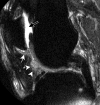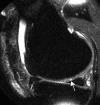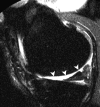Tibiofemoral joint osteoarthritis: risk factors for MR-depicted fast cartilage loss over a 30-month period in the multicenter osteoarthritis study
- PMID: 19635831
- PMCID: PMC2734891
- DOI: 10.1148/radiol.2523082197
Tibiofemoral joint osteoarthritis: risk factors for MR-depicted fast cartilage loss over a 30-month period in the multicenter osteoarthritis study
Abstract
Purpose: To assess baseline factors that may predict fast tibiofemoral cartilage loss over a 30-month period.
Materials and methods: The Multicenter Osteoarthritis (MOST) study is a longitudinal study of individuals who have or who are at high risk for knee osteoarthritis. The HIPAA-compliant protocol was approved by the institutional review boards of all participating centers, and written informed consent was obtained from all participants. Magnetic resonance (MR) images were read according to the Whole-Organ Magnetic Resonance Imaging Score (WORMS) system. Only knees with minimal baseline cartilage damage (WORMS < or = 2.5) were included. Fast cartilage loss was defined as a WORMS of at least 5 (large full-thickness loss, less than 75% of the subregion) in any subregion at 30-month follow-up. The relationships of age, sex, body mass index (BMI), ethnicity, knee alignment, and several MR features (eg, bone marrow lesions, meniscal damage and extrusion, and synovitis or effusion) to the risk of fast cartilage loss were assessed by using a multivariable logistic regression model.
Results: Of 347 knees, 90 (25.9%) exhibited cartilage loss, and only 20 (5.8%) showed fast cartilage loss. Strong predictors of fast cartilage loss were high BMI (adjusted odds ratio [OR], 1.11; 95% confidence interval [CI]: 1.01, 1.23), the presence of meniscal tears (adjusted OR, 3.19; 95% CI: 1.13, 9.03), meniscal extrusion (adjusted OR, 3.62; 95% CI: 1.34, 9.82), synovitis or effusion (adjusted OR, 3.36; 95% CI: 0.91, 12.4), and any high-grade MR-depicted feature (adjusted OR, 8.99; 95% CI: 3.23, 25.1).
Conclusion: In participants with minimal baseline cartilage damage, the presence of high BMI, meniscal damage, synovitis or effusion, or any severe baseline MR-depicted lesions was strongly associated with an increased risk of fast cartilage loss. Patients with these risk factors may be ideal subjects for preventative or treatment trials.
Figures





Similar articles
-
Risk factors for magnetic resonance imaging-detected patellofemoral and tibiofemoral cartilage loss during a six-month period: the joints on glucosamine study.Arthritis Rheum. 2012 Jun;64(6):1888-98. doi: 10.1002/art.34353. Epub 2011 Dec 27. Arthritis Rheum. 2012. PMID: 22213129 Clinical Trial.
-
Baseline radiographic osteoarthritis and semi-quantitatively assessed meniscal damage and extrusion and cartilage damage on MRI is related to quantitatively defined cartilage thickness loss in knee osteoarthritis: the Multicenter Osteoarthritis Study.Osteoarthritis Cartilage. 2015 Dec;23(12):2191-2198. doi: 10.1016/j.joca.2015.06.017. Epub 2015 Jul 8. Osteoarthritis Cartilage. 2015. PMID: 26162806 Free PMC article.
-
Factors associated with meniscal extrusion in knees with or at risk for osteoarthritis: the Multicenter Osteoarthritis study.Radiology. 2012 Aug;264(2):494-503. doi: 10.1148/radiol.12110986. Epub 2012 May 31. Radiology. 2012. PMID: 22653191 Free PMC article.
-
Subchondral cystlike lesions develop longitudinally in areas of bone marrow edema-like lesions in patients with or at risk for knee osteoarthritis: detection with MR imaging--the MOST study.Radiology. 2010 Sep;256(3):855-62. doi: 10.1148/radiol.10091467. Epub 2010 Jun 8. Radiology. 2010. PMID: 20530753 Free PMC article.
-
[Current MR imaging of cartilage in the context of knee osteoarthritis (part 2) : Cartilage pathologies and their assessment].Radiologie (Heidelb). 2024 Apr;64(4):304-311. doi: 10.1007/s00117-023-01253-1. Epub 2024 Jan 3. Radiologie (Heidelb). 2024. PMID: 38170243 Review. German.
Cited by
-
Association of adipokines with severity of knee osteoarthritis assessed clinically and on magnetic resonance imaging.Osteoarthr Cartil Open. 2023 Aug 12;5(4):100405. doi: 10.1016/j.ocarto.2023.100405. eCollection 2023 Dec. Osteoarthr Cartil Open. 2023. PMID: 37664871 Free PMC article.
-
Effect of Knee Extensor Strength on Incident Radiographic and Symptomatic Knee Osteoarthritis in Individuals With Meniscal Pathology: Data From the Multicenter Osteoarthritis Study.Arthritis Care Res (Hoboken). 2016 Nov;68(11):1640-1646. doi: 10.1002/acr.22889. Epub 2016 Oct 1. Arthritis Care Res (Hoboken). 2016. PMID: 26991698 Free PMC article.
-
Cross-sectional and longitudinal reliability of semiquantitative osteoarthritis assessment at 1.0T extremity MRI: Multi-reader data from the MOST study.Osteoarthr Cartil Open. 2021 Sep 20;3(4):100214. doi: 10.1016/j.ocarto.2021.100214. eCollection 2021 Dec. Osteoarthr Cartil Open. 2021. PMID: 36474762 Free PMC article.
-
Implantable sensor technology: measuring bone and joint biomechanics of daily life in vivo.Arthritis Res Ther. 2013 Jan 31;15(1):203. doi: 10.1186/ar4138. Arthritis Res Ther. 2013. PMID: 23369655 Free PMC article. Review.
-
Prevalence of abnormalities in knees detected by MRI in adults without knee osteoarthritis: population based observational study (Framingham Osteoarthritis Study).BMJ. 2012 Aug 29;345:e5339. doi: 10.1136/bmj.e5339. BMJ. 2012. PMID: 22932918 Free PMC article.
References
-
- Amin S, LaValley MP, Guermazi A, et al. The relationship between cartilage loss on magnetic resonance imaging and radiographic progression in men and women with knee osteoarthritis. Arthritis Rheum 2005; 52: 3152– 3159 - PubMed
-
- Bruyere O, Genant H, Kothari M, et al. Longitudinal study of magnetic resonance imaging and standard x-rays to assess disease progression in osteoarthritis. Osteoarthritis Cartilage 2007; 15: 98– 103 - PubMed
-
- Davies-Tuck ML, Wluka AE, Wang Y, et al. The natural history of cartilage defects in people with knee osteoarthritis. Osteoarthritis Cartilage 2008; 16: 337– 342 - PubMed
-
- Ding C, Cicuttini F, Scott F, Cooley H, Boon C, Jones G. Natural history of knee cartilage defects and factors affecting change. Arch Intern Med 2006; 166: 651– 658 - PubMed
Publication types
MeSH terms
Grants and funding
LinkOut - more resources
Full Text Sources
Medical

